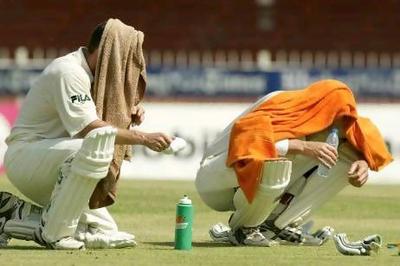by Rehan
(Saudi Arabia)

Matthew Hayden Batting In The Extreme Sharjah Heat / Photo : Hamish Blair / Getty Images
Hello Coach,
Greetings from Saudi Arabia. We are playing cricket in hot and dry weather at 50•c+ . The grounds here are not grassy, they are all sand( leveled and rolled) and the pitch is made up of concrete or cement.As the conditions are hot and the out field is really rough the cricket ball gets roughed up in the 3rd over. We try to keep one side shiny as much possible.
How can we make use of this ball and what plan should be applied? I am medium fast bowler, I love bowling furiously fast but due to un-even surface it becomes almost impossible because of injury factor.
Your fast bowling tips would be highly appreciated, as I am desparetly looking forward to getting more wickets this season.
Best Regards,
Ray.
Ps: as the ball becomes heavy and rough, it requires a lot more energy to bowl.
Hi Ray, thanks for the letter from Saudi Arabia, its one of the things I love about this website is that I get to meet cricketers and cricket lovers from all over the world.
A great deal of respect goes out to you guys playing out there in those conditions, I know that in 2001 Pakistan played Australia in Sharjah in temperatures of 50 celsius and it was unbelievably tough on the players.
I thought the game should have been called off because it was too dangerous, players were having to jump into ice baths after 2-3 over spells !
I am sure you are all experienced of how to protect yourselves in that type of heat, taking care of hydration etc.
The basics for bowling still hold true in the tough conditions that you play in, just that the windows of opportunity to strike and take wickets with the new ball last three overs rather than 10 – 15 overs in normal conditions.
I don’t see any way around the damage that the conditions do to the ball, so how can you use this to your advantage?
Some suggestions for you …
Winning cricket comes from a positive mindset, you must still look to take wickets with the new ball and every time you get a new batter to the crease.
The second opportunity to take wickets comes from the pressure created by controlling the run rate.
Let’s separate those two aspects of game strategy so that you can use them separately.
Taking wickets with the new ball and when you have a new batter at the crease.
The new ball lasts for three overs so you need to make sure you are bowling at middle and off stump so that you have all three key dismissals in play for each ball.
Namely, bowled, LBW and caught behind.
You will have a normal new ball field, with some slips, probably a 6-3 off side field with a fine leg, midwicket and mid on controlling the leg side.
When you get a new batter to the crease, go back to this attacking field setting, you need to strike again before the batter gets themselves in. So you make sure you go back to bowling straight at middle and off again.
When the new ball is gone, you will go to a more conservative field, you will have two choices … to either bowl to an off side field or a split field.
The off side field will be when the batters have established a partnership, you want to control the run scoring, stop strike rotation and bowl maidens.
You will bowl six inches to a foot outside off stump to force the batter to score on the off side, your field will support this with a point, extra cover or cover and mid off.
Batters dislike maidens, they want to score, so when the bowling partnership can string some maidens together it invariably brings a wicket through the pressure built up on the batters.
Make sure you observe closely where each batter looks to get off strike so that you can put a fielder in those key inner ring fielding positions.
You want to keep the new batter or the batter who struggles to rotate strike at one end, this pressure will bring wickets.
If the concrete wickets keep low because the ball is damaged, then bowl straight for the LBW.
Set a split field with fielders covering square leg and mid wicket, as well as cover and point so that you can hold the batter on strike.
Reverse Swing: Normally with reverse swing you let one side of the ball deteriorate and look after the other. See if you can work really hard to keep one side as polished as possible to create a significant difference between the two sides of the ball.
If there is an opportunity to get the ball to reverse swing then set the split field again so you can bowl for the LBW. Protect square leg and mid wicket with fielders to bowl to this field.
Best wishes with your cricket, regards Coach
Join in and write your own page! It’s easy to do. How? Simply click here to return to Ask Coach ? .

About Richard Pybus
I'm Richard Pybus, I've coached Pakistan, Bangladesh, Middlesex, Titans and the Cape Cobras in South Africa and the goal of this site is to help you to play winning cricket.
